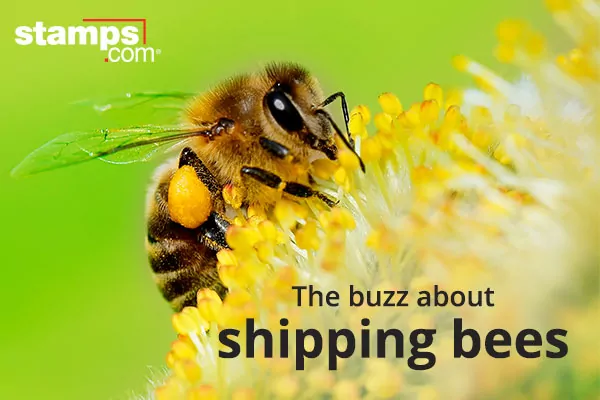Shipping Bees with USPS and Stamps.com

If you’re running an apiary or beekeeping business, you’re probably selling products such as honey, beeswax, or bee pollen. Bee operations also make revenue by selling actual live bees. But can you mail bees through the USPS? Yes, but there are some guidelines to keep in mind.
Types of bees
First, some basic science. A hive consists of three types of bees:
- the female queen bee
- female worker/attendant bees
- male drones
Only queen honeybees and female worker/attendant honeybees can be mailed via the USPS. Whole colonies cannot be shipped. If you’re sending a starter hive of live bees, keep in mind that the type of bee you’re sending will determine the mail class you can use. When mailing bees with Stamps.com, you should always print a shipping label with embedded barcode tracking. In the Stamps.com software, under the “Packages” section, you can select one of our “Shipping Label” options. You can easily print a trackable label on plain paper or on one of our self-adhesive labels, such as these 4 1/4″ x 6 3/4″ shipping labels. As a Stamps.com customer, you’ll receive the discounted PC Postage (Commercial Base) rate, so you’ll save money when you print postage with us!
Queen Honeybees and Worker Bees
Queen honeybees can travel in style and be shipped by the faster air mail methods. Female worker/attendant honeybees can only be shipped via surface-based mail methods. Generally, Priority Mail, Priority Mail Express and First-Class Mail pieces will generally be shipped by air. The queen doesn’t have to fly alone, though, and in accordance with USPS regulations, she can be joined by up to eight female attendant/worker honeybees.
When going by surface mail methods, your shipment will need special care, and if you’re shipping queen honeybees or female worker/attendant honeybees via ground transportation, you would need to add the Special Handling fee. The good news is that you can do this easily in Stamps.com! In the software, click on “Add’l Options” and hit “Select…” Click on “Special Contents” and select the Content Type of “Live Animal (with Fee).”
Packaging
When shipping bees, it’s obviously important to spend some time ensuring your package is safe for both the bees and for the postal workers. The mailpiece should be constructed in such a way as to provide adequate air and ventilation—a temperature range of 40° to 100° F is recommended—and secure enough to prevent any bees from escaping. A third consideration is strength, as you need to avoid having your box getting crushed during transit. There are a number of solutions, including using screened wooden rectangular boxes or reinforced bee shipping boxes. For mailpieces sent by surface transportation, you must mark your box on the address side with the following descriptors: “Live Bees” and “Surface Only/Surface Mail Only.” Plainly mark “Live Queen Bees” on the address side for mailpieces sent with queen honeybees.
International Mailing
Before mailing bees abroad, we strongly recommend checking individual country listings for restrictions. Bees may be prohibited entirely, or stringent importation rules may apply. For example, when mailing bees to Argentina, you would need to have the Argentine Consul countersign a health certificate. If you’re sending live bees to Sweden, they must be sent directly to the Department of Bee Research of the University of Agricultural Sciences at its campus in Uppsala, Sweden. Learn more about international shipping restrictions by country.
For more information on USPS regulations regarding mailing bees, please see:
https://pe.usps.com/text/pub52/pub52c5_008.htm
For the United States Department of Agriculture’s regulations, please see: